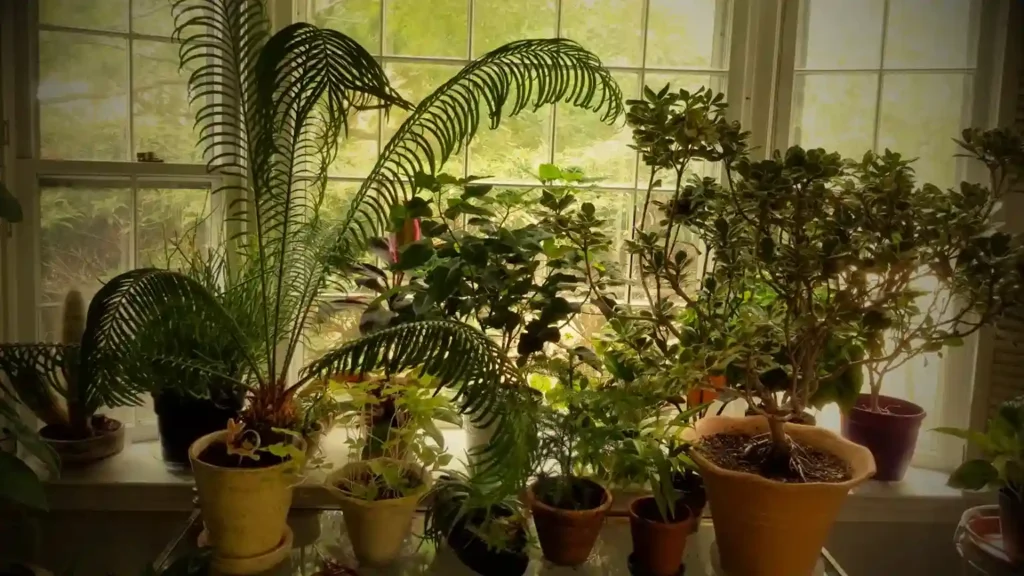If you’re looking to brighten up a dim space with greenery, several indoor plants thrive in low-light conditions. These plants are not only resilient but also easy to care for, making them perfect for beginners or busy lifestyles. Here are some of the top choices:
Snake Plant (Sansevieria)
Also known as “mother-in-law’s tongue,” this hardy plant can survive in a wide range of light conditions. Its tall, upright leaves make it a stylish addition to any room, and it requires minimal watering.
Pros:
- Extremely low maintenance.
- Tolerates neglect and infrequent watering.
- Helps purify air by removing toxins.
Cons:
- Slow growth.
- Overwatering can cause root rot.
ZZ Plant (Zamioculcas zamiifolia)
With its glossy, waxy leaves, the ZZ plant adds elegance to any space. It thrives in extremely low light and requires only occasional watering, making it perfect for low-maintenance plant lovers.
Pros:
- Thrives in very low light.
- Requires infrequent watering.
- Attractive, modern aesthetic.
Cons:
- Toxic to pets if ingested.
- Slow-growing.
Pothos (Epipremnum aureum)
Often called “Devil’s Ivy,” Pothos is a popular trailing plant that grows well in dim spaces. It’s easy to propagate and thrives with little care, making it a favorite for homes and offices.
Pros:
- Easy to propagate and care for.
- Grows quickly, even in poor lighting.
- Purifies indoor air.
Cons:
- Leaves may turn yellow in overly dark conditions.
- Toxic to pets if consumed.
Peace Lily (Spathiphyllum)
This low-light-loving plant produces beautiful white flowers and purifies the air. Peace lilies prefer consistent moisture and are ideal for adding a touch of sophistication to low-light corners.
Pros:
- Air-purifying qualities.
- Adds a touch of sophistication to spaces.
- Thrives in humid environments.
Cons:
- Requires consistent moisture.
- Toxic to pets and children.
Cast Iron Plant (Aspidistra elatior)
True to its name, the Cast Iron Plant is nearly indestructible. It can handle neglect, low light, and infrequent watering, making it a reliable choice for dim indoor spaces.
Pros:
- Extremely durable and hardy.
- Tolerates neglect and low light.
- Long-lived with proper care.
Cons:
- Very slow growth.
- Leaves may brown with overwatering.
Chinese Evergreen (Aglaonema)
Known for its colorful, patterned leaves, this plant thrives in low light and adapts to various indoor environments. It’s also incredibly easy to maintain.
Pros:
- Low maintenance and adaptable.
- Tolerates a variety of indoor environments.
- Available in a variety of colors.
Cons:
- Sensitive to cold drafts.
- Toxic to pets.
Parlor Palm (Chamaedorea elegans)
This compact palm brings a tropical vibe to your home. It grows slowly and does well in indirect or low light, making it a great choice for small spaces.
Pros:
- Easy to care for and grows well in low light.
- Non-toxic to pets.
- Ideal for small spaces.
Cons:
- Slow growth.
- Requires occasional misting to prevent dryness.
Boston Fern (Nephrolepis exaltata)
A classic indoor plant, the Boston Fern thrives in indirect light and high humidity. It’s perfect for bathrooms or areas with naturally moist air.
Pros:
- Excellent air-purifying qualities.
- Adds a soft, natural look to spaces.
Cons:
- Needs high humidity and regular watering.
- Can shed leaves in dry conditions.
Heartleaf Philodendron (Philodendron hederaceum)
This lush, trailing plant grows well in low to moderate light. Its heart-shaped leaves and easy care requirements make it a popular houseplant.
Pros:
- Very easy to grow and propagate.
- Tolerates a wide range of lighting conditions.
Cons:
- Toxic to pets.
- Requires occasional pruning to prevent legginess.
Spider Plant (Chlorophytum comosum)
Spider plants thrive in various lighting conditions, including low light. They produce small “baby” plants that can be propagated, adding charm and life to your home.
Pros:
- Very forgiving and easy to care for.
- Non-toxic to pets.
- Propagates easily.
Cons:
- Can become root-bound in small pots.
- Leaves may brown if overwatered or exposed to dry air.
Conclusion
By choosing these plants, you can create a lush indoor environment, even in spaces with limited natural light. Would you like tips on care or placement for any of these plants?
Low-light indoor plants make it easy to bring greenery into spaces where natural light is scarce. From the hardy Snake Plant to the elegant Peace Lily, these plants cater to different aesthetics and care preferences. While each plant has its pros and cons, most are forgiving and suitable for beginners. By selecting the right plant for your space and lifestyle, you can enjoy the beauty of nature, even in the dimmest corners of your home.
Would you like assistance selecting the perfect plant or care tips for any of these option

